Enhanced TDS
Identification & Functionality
- Chemical Family
- RTU Product Type
- Technologies
- Product Families
Features & Benefits
- Ready-to-Use Product Features
- Product Features
- Very good mechanical and electrical properties.
- Good temperature shock resistance.
- High resistance to erosion by UV radiation.
- High tracking and arc resisstance.
The use of silanised silica flour insures stable dielectrical properties under outdoor humid conditions.
Applications & Uses
- Composites Processing Methods
- Cure Method
- Product End Uses
- System Preparation
General instructions for preparing liquid resin systems
The following is the suggested preheat temperature of ARALDITE Resin and ARADUR Hardener:
ARALDITE resin: 50°C for 6 to 12 hrs
ARADUR hardener: room temperature
Mix all of the components together very thoroughly (the mixture temperature will be reached at or about 60°C. If lower mix viscosity is expected, preheat resin at higher temperature but not exceed 80°C under vacuum.Proper mixing will result in:
- Better flow properties and reduced tendency to shrinkage
- Lower internal stresses and therefore improved mechanical properties on object
- Improved partial discharge behaviour in high voltage applications.
For the mixing of medium to high viscous ARALDITE casting resin systems and for mixing at lower temperatures, it is recommended special thin film degassing mixers that may produce additional self-heating of 10-15°C as a result of friction. For low viscous ARALDITE casting resin systems, conventional anchor mixers are usually sufficient.
In larger plants, two pre-mixers are used to mix the individual components (resin, hardener) under vacuum. Metering pumps then feed these premixes to the final mixer or a continuous mixer. The individual premix can be stored at elevated temperature (about 60°C) for up to about 1 week, depending on formulation. Intermittent agitation during storage is advisable to prevent filler sedimentation.
Mixing time can vary from 0.5 to 3 hours, depending on mixing temperature, quantity, mixing equipment and the particular application. The required vacuum is 0.5 to 8 mbar.
The vapour pressure of the individual components should be taken into account.- Applications
- Outdoor electrical insulating parts, as apparatus components, bushings, line post and pin insulators in the medium voltage range.
- All components for humid indoor medium and high voltage applications.
Technical Details & Test Data
- Specific Instructions
Dilute leftover mix at the end of a shift with the resin component prior to storage overnight or over the weekend. Piping containing prefilled components or casting mixes should be cooled immediately after work to prevent sedimentation and/or undesired viscosity increases. This helps minimize material losses and cleaning work.
Mould temperature
APG process : 140 - 160°C
Conventional vacuum casting : 70 - 100°C
Demoulding times (depending on mould temperature and casting volume)
APG process : 10 - 40 min
Conventional vacuum casting : 5 - 8h
Cure conditions
APG process (minimal postcure) : 4h at 130°C or 3h at 140°C
Conventional vacuum casting : 12h at 130°C or 8h at 140°CTo determine whether crosslinking has been carried to completion and the final proper-ties are optimal, it is necessary to carry out relevant measurements on the actual object or to measure the glass transition temperature. Different gel and postcuring cycles in the manufacturing process could influence the crosslinking and the glass transition temperature respectively.
- Mechanical & Physical Properties
System tested:
ARALDITE CW 5522 CI / ARADUR HY 5522 CI
Mix ratio (PBW) : 100 / 20
Determined on standard test specimen at 23°C
cured for 2h at 100°C + 16h at 140°CProperty
Test Method
Unit
Value
Tensile strength
ISO R 527
N/mm²
85 - 95
Elongation at break
ISO R 527
%
1.2 - 1.6
E modulus from tensile test
ISO R 527
N/mm²
9900 - 10300
Flexural strength at 23°C
ISO 178
N/mm²
120 - 130
Surface strain at 23°C
ISO 178
%
1.1 - 1.5
E modulus from flexural test
ISO 178
N/mm²
9850 - 10250
Impact strength
ISO 179
kJ/m²
9 - 11
Critical stress intensity factor (Kic)
MPa·m½
2.15 - 2.35
Specific energy at break (Gic)
J/m²
470 - 500
Martens temperature
DIN 53458
°C
85 - 95
Glass transition temperature (DSC)
IEC 1006
°C
95 - 105
Coefficient of linear thermal expansion
DIN 53752
K⁻¹
35 - 38 × 10⁻⁶
Thermal conductivity similar to
ISO 8894-1
W/m·K
0.7 - 0.9
Flammability
UL 94
class
HB
Thickness of specimen (4 mm)
class
HB
Thickness of specimen (12 mm)
class
V1
Water absorption (specimen: 50x50x4 mm)
ISO 62
% by wt.
0.10 - 0.20
10 days at 23°C
% by wt.
0.08 - 0.15
60 min at 100°C
°C
350
Decomposition temperature (heating rate: 10K/min)
DTA
°C
350
Density (Filler load: 60% by wt.)
DIN 55990
g/cm³
1.6 - 1.7
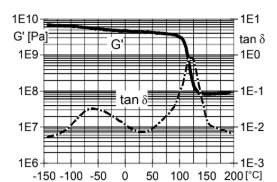
Fig.5.1: Shear modulus (G') and mechanical loss factor (tan δ) in a function of temperature
(measured at 1 Hz)
(ISO 6721/ DIN 53445 method C)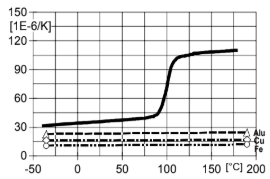
Fig.5.2: Coefficient of linear thermal expansion (α) in a function of temperature
(reference temperature: 23°C)
(DIN 53752)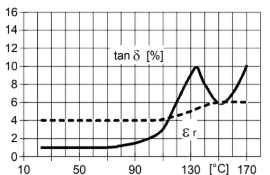
Fig.6.1: Loss factor (tan δ) and dielectric constant (εr) as a function of Temperature
(measurement frequency: 50 Hz)
IEC 250/ DIN 53483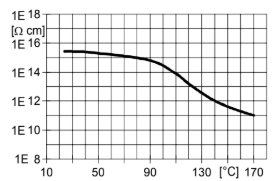
Fig.6.2: Volume resistivity (ρ) as a function of temperature
(measurement voltage: 1000 V)
IEC 93/ DIN 53482- Gelation / Cure Time
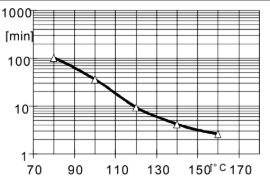
Fig.4.4: Geltime measured with Gelnorm Instrument in f(T)
(DIN 16945/6.3.1)
Safety & Health
- First Aid
- Contamination of the eyes by resin, hardener or casting mix should be treated immediately by flushing with clean, running water for 10 to 15 minutes. A doctor should then be consulted.
- Material smeared or splashed on the skin should be dabbed off, and the contaminated area then washed and treated with a cleansing cream (see above). A doctor should be consulted in the event of severe irritation or burns. Contaminated clothing should be changed immediately.
- Anyone taken ill after inhaling vapours should be moved out of doors immediately. In all cases of doubt call for medical assistance.
- Handling Precautions
Safety precautions at workplace:
protective clothing : yes
gloves : essential
arm protectors : recommended when skin contact likely
goggles/safety glasses : yes
respirator/dust mask : recommended
Skin protection
Before starting work : Apply barrier cream to exposed skin
after washing : Apply barrier or nourishing cream
Cleansing of contaminated skin : Dab off with absorbent paper, wash with warm water and alkali-free soap, then dry with disposable towels. Do not use solvents
Clean shop requirements : Cover workbenches, etc. with light coloured paper. Use disposable breakers, etc.
Disposal of spillage Soak up with sawdust or cotton waste and deposit in plastic-lined binVentilation:
of workshop Renew air 3 to 5 times an hour
of workplace Exhaust fans. Operatives should avoid inhaling vapours.
Storage & Handling
- Storage Conditions
- ARADUR HY 5522 CI contains accelerator. Prolonged storage at high ambient temperatures results in an undesirable increase in its viscosity and impairs the reactivity of the ARALDITE Casting Resin system. ARADUR HY 5522 CI is sensitive to moisture. Partly emptied containers must be resealed immediately.
- Prefilled liquid product always shows small filler sedimentation. Before partial use we recommend to stir up carefully the components or to use each container as complete unity.
- The components have to be stored under dry conditions at 6-35°C, in tightly sealed original containers. Under these conditions, the shelf life will correspond to the expiry date stated on the label. After this date, the product may be processed only following reanalysis. Partly emptied containers should be closed tightly immediately after use.
Other
- Application Information
Value Units Test Method / Conditions Mix Ratio 0.2 %(W) %(W) Hardener : Resin - Physical Properties
Value Units Test Method / Conditions Glass Transition Temperature (Tg) 95.0 °C °C
